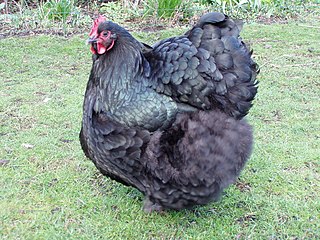
The Orpington is a British breed of chicken. It was bred in the late nineteenth century by William Cook of Orpington, Kent, in south-east England. It was intended to be a dual-purpose breed, to be reared both for eggs and for meat, but soon became exclusively a show bird.

The Malay is a breed of game chicken. It is among the tallest breeds of chicken, and may stand over 90 cm high. The Malay is bred principally in Europe, and in Australia and the United States. It was derived, partly in Devon and Cornwall in south-west England, from birds imported from Indian subcontinent or South-east Asia in the first decades of the nineteenth century, when large birds of this type were widespread in northern India, in Indonesia and in the Malay Peninsula.
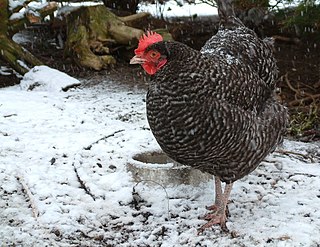
The Marans, French: Poule de Marans, is a breed of chicken from the port town of Marans, in the département of Charente-Maritime, in the Nouvelle-Aquitaine region of south-western France. It was created with the local feral chickens descended from fighting game chickens carried from Indonesia and India. Those original Marandaise fowl were "improved" for the table through recombination with imported Croad Langshans. A favourite at poultry shows, it is a dual-purpose fowl known both for its extremely dark eggs and fine meat qualities.
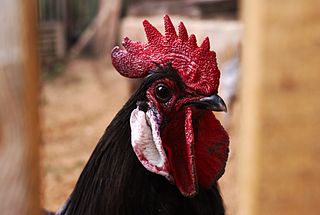
The Andalusian or Blue Andalusian, Spanish: Andaluza Azul, is a breed of domestic chicken indigenous to the autonomous community of Andalusia in south-west Spain. It is distributed through much of the countryside of Córdoba and Seville, and is concentrated particularly in the area of Utrera, which is considered the heartland of the breed. In 2009 the population was estimated at 10,000 birds.

The Hamburg, Dutch: Hollands hoen, German: Hamburger, is a breed of chicken which is thought to have originated in Holland sometime prior to the fourteenth century. The name may be spelled Hamburgh in the United Kingdom and in Australia.

The Lakenvelder or Lakenfelder is a breed of domestic chicken from the Nordrhein-Westfalen area of Germany and neighbouring areas of the Netherlands. It was first recorded in 1727.

The Barbu d'Uccle or Belgian d'Uccle, Dutch: Ukkelse Baardkriel, is a Belgian breed of bearded bantam chicken. It was first bred in the town of Uccle on the outskirts of Brussels, in central Belgium, in the early years of the twentieth century. It is a true bantam, with no standard-sized large fowl counterpart, and is one of eleven Belgian true bantam breeds.

The Dutch Bantam is a breed of bantam chicken originating in the Netherlands. It is a true bantam, a naturally small bird with no related large fowl from which it was miniaturized. It is kept mainly for exhibition, and has been bred in many color varieties; it is a good layer of small eggs.

The Barbu de Watermael, Dutch: Watermaalse Baardkriel, is a Belgian breed of bantam chicken. It originated in the Belgian town of Watermael-Boitsfort, from which it takes its name, which means "bearded [chicken] from Watermael". It is closely related to the Barbu d'Anvers, but is distinguished from it by its small, backswept crest of feathers. The Barbu de Boitsfort is a rumpless variation, the only difference being that it lacks the uropygium, the part of the anatomy that carries the tail.

The Brabanter is a Dutch breed of crested chicken originating in the historic region of Brabant which straddles Belgium and the Netherlands. It is an ancient breed and is shown in 17th-century paintings. A bantam Brabanter was created in around 1934.
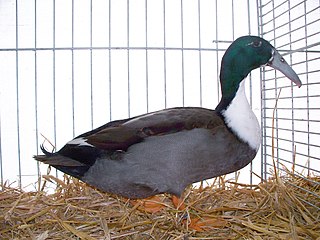
The Hook Bill or Dutch Hookbill is a breed of domestic duck characterised by an unusual down-curved beak. It is an ancient breed, and has been documented since the seventeenth century. Speculation that it originated in Asia, or is related to the Indian Runner, is apparently unsubstantiated.
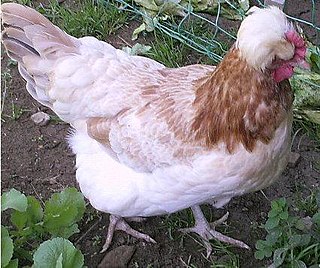
The Sulmtaler is an Austrian breed of domestic chicken. It originates in the Sulmtal, the valley of the Sulm river, in southern Styria, in the south-east of Austria, and takes its name from that valley.
A Tjasker is a type of small drainage windmill used in the Netherlands and Germany. There are 28 tjaskers remaining the Netherlands.

The Friesian or Frisian, Dutch: Fries Hoen, is an ancient Dutch breed of chicken. It originates in Friesland, on the North Sea coast of the northern Netherlands.
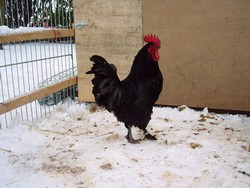
The Poule d'Estaires is a breed of domestic chicken from the Nord – Pas de Calais region of north-eastern France. It is a variety of the Langshan breed imported to England from China in 1872, and exported from there to Europe soon after. Some were raised in the Pas-de-Calais département, and others in the neighbouring Nord département, particularly in the areas of Estaires, La Gorgue, Laventie and Merville, from which birds were supplied to Lille.
The Belgian Bantam, Dutch: Belgisch kriel, French: Naine belge, is a breed of bantam chicken from Belgium. It is a true bantam, and has no full-sized counterpart; cocks weigh about 650 grams and hens about 550 g. It is in danger of extinction; in 2010 a total of 168 birds were counted in the whole of Belgium. Fourteen colour patterns are recognised in the European standard.
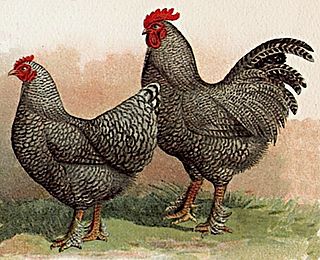
The Malines, Dutch: 'Mechelse Koekoek', is a Belgian breed of large domestic chicken. It originates from the area of Mechelen, in the province of Antwerp in Flanders, for which it is named. It was created in the nineteenth century by cross-breeding local cuckoo-patterned farm chickens with various different types of imported Oriental chicken. With the Jersey Giant, it is among the heaviest of all chicken breeds. It is valued for the quality of its meat, which is pale in colour and fine-textured.

The Krüper is a German breed of creeper chicken. It originates in the former Dutchy of Berg, now the Bergisches Land in western Germany, and is one of three chicken breeds from that area, the others being the Bergische Kräher and the Bergische Schlotterkamm. It belongs to the group of original European creeper breeds. The breed has normal-sized and bantam varieties.

The Niederrheiner is a German breed of chicken. It is named for the Niederrhein or Lower Rhine region where it originated in the early twentieth century, and derives principally from the Dutch North Holland Blue meat chicken. It was recognized in Germany in 1943. In the twenty-first century it is an endangered breed.
















